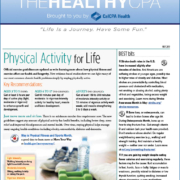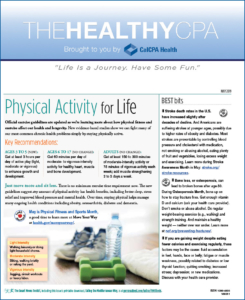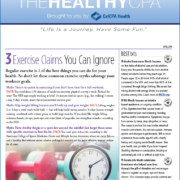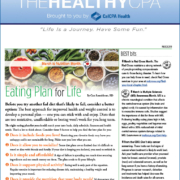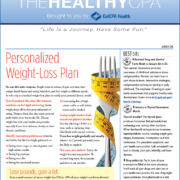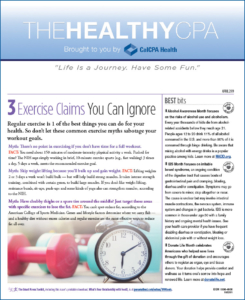 The eMagazine dedicated to improving members’ well-being
The eMagazine dedicated to improving members’ well-being
- 3 Exercise Claims You Can Ignore
- Tricks for Better Eating
- Living with a Chronic Condition
- CANCER: Risks You Can Control
- Is Anxiety Holding You Back?
In each issue you will find information and inspiration to help you with your health and wellness goals.
Anthem Blue Cross Announces Multi-Year Agreement with Sutter Health
This week Anthem Blue Cross announced that it worked closely with Sutter Health and came to an agreement for a new multi-year contract that provides Anthem members with continued in-network access to Sutter facilities and with affiliated physicians through December 31, 2022.
This agreement means that Sutter Health will remain in the Anthem Blue Cross network, and CalCPA Health HMO, PPO and HSA members may access Sutter facilities and physicians. To learn more about this agreement, please visit Anthem’s site.
If you have any questions, call Banyan Administrators at (877) 480-7923 or email for more information.
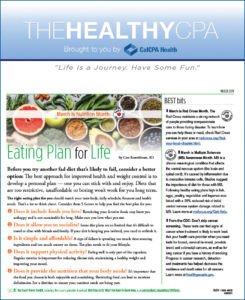 The eMagazine dedicated to improving members’ well-being
The eMagazine dedicated to improving members’ well-being
- Eating Plan for Life
- Managing Life’s Transitions: Ready or Not?
- Good Manners in the Smartphone Age
- Kidney Stones 101
- ACHOO! Spring Allergies and YOU
- Traveling Smart
- Poison Prevention
- SIGNS You Need Medical Care
In each issue you will find information and inspiration to help you with your health and wellness goals.
 The eMagazine dedicated to improving members’ well-being
The eMagazine dedicated to improving members’ well-being
- Your Heart’s Must-Haves
- Slash the Salt
- Brain Workouts
- Active at 50+
- Save a Life With CPR
In each issue you will find information and inspiration to help you with your health and wellness goals.

It’s 3 a.m. and you’re running a high fever. Everything hurts and your doctor’s office is closed. We’ve all been there – wondering whether to go to the emergency room … or wait?
When you know it’s not a matter of life or death, an urgent care center or retail health clinic may be your best option. These facilities are often open after hours, seven days a week. Plus, they cost less and have shorter wait times than emergency rooms. Be proactive; find your closest in-network urgent care center or retail clinic before you get sick or hurt. The more you’re prepared, the faster you can get help when you need it!

How does smoking hurt thee? Let me count the ways! As a major risk factor for many serious health problems, smoking is especially bad for your heart. When combined with other risk factors, such as high cholesterol, high blood pressure and being overweight
or obese, smoking raises your risk for heart disease, the leading cause of death in the United States.
If you want to live a heart-healthy lifestyle, don’t smoke. If you need help quitting, talk
to your doctor about resources, strategies and nicotine replacement therapy. Within a
few weeks to a few months of kicking the habit, you’ll already have lowered your risk
for heart disease.

Every November through December, you’re surrounded by food – lots of it. At the same time, the holidays can be very stressful if you’re hosting loved ones or missing them.
Food plus stress is often a recipe for disaster, but there are steps you can take to beat holiday excess:
- Fill up on healthy snacks, like fruits, veggies and nuts, before meals.
- Bring your own low-calorie dish to potlucks.
- Watch your portion size, especially at buffets. It’s okay to enjoy some of your favorites in moderation.
- Skip sugary drinks, fatty sauces and salty processed foods.
- Make fresh fruit your dessert.
Also, plan at least two-and-a-half hours of physical activity a week. You can sneak workouts between parties or bring others along for a walk or dancing.
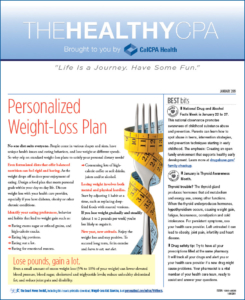 The eMagazine dedicated to improving members’ well-being
The eMagazine dedicated to improving members’ well-being
- Personalized Weight-Loss Plan
- Healthy Stress Busters
- Why the 3,500-Calorie Rule Doesn’t Always Work
- Walking: Step It Up a Notch
- Why You Shouldn’t Self Diagnose
In each issue you will find information and inspiration to help you with your health and wellness goals.

Ready to take the plunge into parenthood? You can start by preparing your body for baby.
First, talk to your doctor and share any health conditions, lifestyle behaviors (such as smoking or alcohol use), and medication or vaccination history that might get in the way
of either getting pregnant or having a healthy pregnancy. To help prevent birth defects of the spine and brain, women should ask about taking 400 micrograms of folic acid every day for a month before trying to get pregnant. Also, getting pregnant at a healthy weight lowers a woman’s risk for developing gestational diabetes and other pregnancy-related problems. A little planning can make a big difference for your baby’s future.
Resources
Plans & Services
News
Contact Us
Monday – Friday,
8am to 5pm (PST)
(877) 480-7923
Click below to contact our
Banyan Customer Service Team

